The Hierarchy window
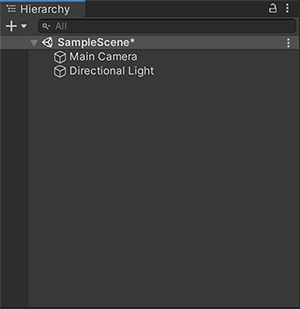
The Hierarchy window displays every GameObjectThe fundamental object in Unity scenes, which can represent characters, props, scenery, cameras, waypoints, and more. A GameObject’s functionality is defined by the Components attached to it. GameObjectThe fundamental object in Unity scenes, which can represent characters, props, scenery, cameras, waypoints, and more. A GameObject’s functionality is defined by the Components attached to it. More info
See in Glossary in a Scene, such as models, Cameras, or PrefabsAn asset type that allows you to store a GameObject complete with components and properties. The prefab acts as a template from which you can create new object instances in the scene. Glossary in a Scene, such as models, Cameras, or PrefabsAn asset type that allows you to store a GameObject complete with components and properties. The prefab acts as a template from which you can create new object instances in the scene. More info
See in Glossary. You can use the Hierarchy window to sort and group the GameObjects you use in a Scene. When you add or remove GameObjects in the Scene view, you also add or remove them from the Hierarchy window.
The Hierarchy window can also contain other Scenes, with each SceneA Scene contains the environments and menus of your game. Think of each unique Scene file as a unique level. In each Scene, you place your environments, obstacles, and decorations, essentially designing and building your game in pieces. More info
See in Glossary containing their own GameObjects.
Parenting
Unity uses the concept of parent-child hierarchies, or parenting, to group GameObjects. An object can contain other GameObjects that inherit its properties.You can link GameObjects together to help move, scale, or transform a collection of GameObjects. When you move the top-level object, or parent GameObject, you also move all child GameObjects.
You can also create nested parent-child GameObjects. All nested objects are still descendants of the original parent GameObject, or root GameObject.
Child GameObjects inherit the movement and rotation of the parent GameObject. To learn more about this, see documentation on the Transform componentA Transform component determines the Position, Rotation, and Scale of each object in the scene. Every GameObject has a Transform. Transform componentA Transform component determines the Position, Rotation, and Scale of each object in the scene. Every GameObject has a Transform. More info
See in Glossary.
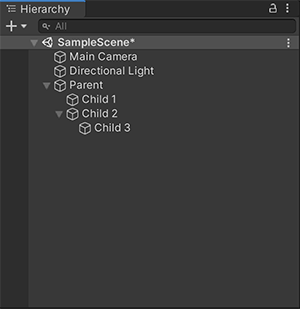
Organize GameObjects
Create new GameObjects
To create a new GameObject in the Hierarchy window:
- Right-click on empty space in the selected Scene.
- Select the GameObject you want to create.
You can also press Ctrl+Shift+N (Windows) or Command+Shift+N (macOS) to create a new empty GameObject.
Note: New GameObjects are created in “rename” mode automatically. To disable this behavior, select the More (⋮) menu in the Hierarchy window and deselect Rename New Objects.
Toggle child GameObject visibility
To toggle the visibility of child GameObjects:
- Select the drop-down arrow (►) to the left of the parent GameObject.
- Press Alt while clicking the drop-down arrow (►) to toggle visibility of all descendant GameObjects of the root GameObject.
- Select the drop-down arrow again (▼) to collapse all descendant GameObjects.
Create child GameObjects
To create a child GameObject:
- Drag the GameObject onto the parent GameObject in the Hierarchy.

Create parent GameObjects
You can add a new GameObject into the Hierarchy view as the parent of existing GameObjects.
To create a parent GameObject:
- Right-click a GameObject, or select multiple GameObjects on the same level and right-click.
- Select Create Empty Parent.
You can also press Ctrl+Shift+G (Windows) or Command+Shift+G (macOS) to create a parent GameObject.
Note: If you have set a default parent GameObject, Create Empty Parent creates the new GameObject as a child of the default parent, not as the parent of the selected GameObjects.
Create sibling GameObjects
A sibling GameObject is a GameObject with the same hierarchy as another child GameObject. To create a sibling GameObject:
- Drag the GameObject above or below an existing GameObject.
- Use the horizontal blue line to determine the order of the GameObject.

Duplicate GameObjects
To duplicate GameObjects, right-click the target GameObject and select Duplicate.
You can also press Ctrl+D (Windows) or Command+D (macOS) to duplicate the selected GameObject.
Paste GameObjects as child
You can cut or copy a selected GameObject and then paste it as a child of another GameObject. Pasted child GameObjects keep their world position.
To paste a GameObject as child:
- Right-click the selected GameObject, and then select Cut or Copy.
- Right-click the intended parent GameObject, and then select Paste as Child.
You can also press Ctrl+Shift+V (Windows) or Command+Shift+V (macOS) to paste a GameObject as a child.
Organize GameObjects with default parent
You can make any GameObject in the Hierarchy window a “default parent”. When you drag a GameObject into the Scene viewAn interactive view into the world you are creating. You use the Scene View to select and position scenery, characters, cameras, lights, and all other types of Game Object. More info
See in Glossary, Unity automatically makes this GameObject the child of the GameObject you set as the default parent.
To make a GameObject a default parent:
- In the Hierarchy window, right-click on the GameObject.
- Select Set as Default Parent.
When you drag a GameObject into the Scene view, in the Hierarchy window, the child GameObject is indented below the default parent GameObject. The name of the default parent GameObject is bold.
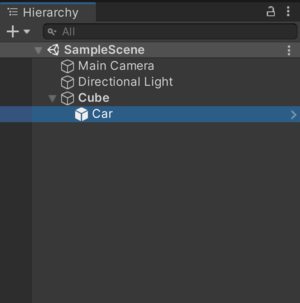
To remove default parent status from a GameObject:
- In the Hierarchy window, right-click on the GameObject.
- Select Clear Default Parent.
The name of the GameObject that was previously the default parent is no longer bold. When you drag a GameObject into the Scene view, it appears at the top level in the Hierarchy window. In other words, Unity does not make this GameObject the child of the GameObject that was previously the default parent.
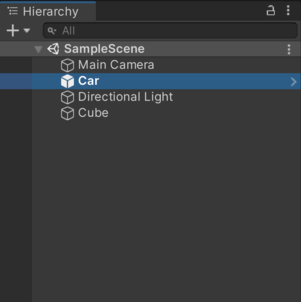
You can only set one default parent per Scene. In the Hierarchy window, if you set a GameObject as the default parent, and then you make a different GameObject in the same Scene the default parent, only the second GameObject is the default parent.
If you have multiple Scenes in the Hierarchy window, and you set default parents in each Scene, when you drag a GameObject into the Scene view, Unity makes the default parent GameObject in the active Scene the parent of the new GameObject.

You can set a keyboard shortcut for the default parent setting in the Shortcuts manager. On the Shortcuts window, assign a keyboard shortcut to Hierarchy View > Set as Default Parent. If there is no default parent set, and in the Hierarchy window you select a GameObject, use the shortcut to make this GameObject the default parent. When a default parent is set, use the shortcut to remove default parent status from any GameObject that has it.
Set Scene visibility and pickability
If you have a scene with many GameObjects, it can be difficult to find and pick specific GameObjects in the Scene view. To clear the Scene view without impacting the visibility or behavior of GameObjects in the game, you can toggle the visibility and pickability of GameObjects from the Hierarchy window:
- To hide and show the GameObject, select Scene visibility.
- To toggle the GameObject’s pickability, select Scene picking.
Note: If you select multiple GameObjects, press H to hide and show them, and L to toggle their pickability.
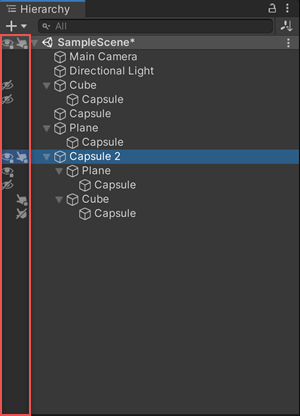
For more information, refer to Scene visibility and Scene picking.
Sort GameObjects
By default, the Hierarchy window lists GameObjects in the order they’re created. You can drag the selected GameObject up or down in the Scene to change the order of the GameObjects.
Alphanumeric sorting
To sort GameObjects in alphanumeric order:
- Select Edit > Preferences (Windows) or Unity > Preferences (macOS).
- Select Enable Alphanumeric Sorting.
When selected, an icon appears in the Hierarchy window that allows you to toggle between Transform sorting (the default value) or Alphabetical sorting.
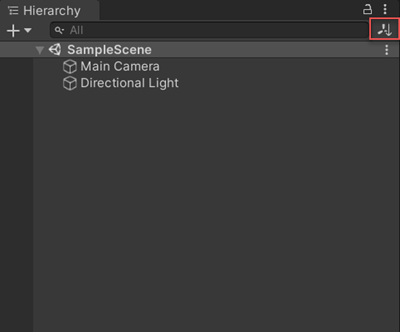
Multi-Scene editing
You can have more than one Scene open in the Hierarchy window at the same time. For more information, see the Multi Scene Editing page.
Override indicator
When you edit a Prefab instance in a Scene, Unity displays a indicator next to the parent GameObject in the hierarchy. This indicator highlights any Prefab that has non-default override values in any of its child GameObjects. To open the Overrides dropdown directly from the Hierarchy window click on the override indicator. The override indicator appears as a blue line in the left side of the margin and is identical to the instance override in the InspectorA Unity window that displays information about the currently selected GameObject, asset or project settings, allowing you to inspect and edit the values. Overrides dropdown directly from the Hierarchy window click on the override indicator. The override indicator appears as a blue line in the left side of the margin and is identical to the instance override in the InspectorA Unity window that displays information about the currently selected GameObject, asset or project settings, allowing you to inspect and edit the values. More info
See in Glossary window. For more information, see Instance overrides.
